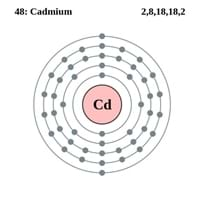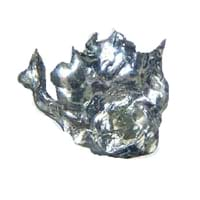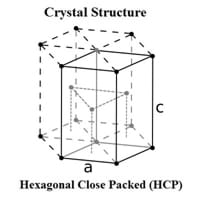Cd Element
Periodic Table
0
Symbol
Cd 0
Group Number
12 6
Period Number
5 3
Block
d block 0
Element Family
Transition Metal 0
CAS Number
7440439 42
Space Group Name
P63/mmc 0
Space Group Number
194.00 5
Facts
0
Interesting Facts
- Naturally occurring minor elements include Cadmium.
- Cadmium is released into atmosphere to control volcanic eruption and forest fires.
- It is used for electroplating of Steel for corrosion resistance.
- It can absorb neutrons and used in nuclear reactor to control atomic fission.
Sources
Found As a By-product, Found in Minerals, Mining 0
History
0
Who Discovered
Karl Samuel Leberecht Hermann and Friedrich Stromeyer 0
Discovery
In 1817 0
Abundance
0
Abundance In Universe
2 * 10-7 % 22
Abundance In Sun
~0.0000006 % 21
Abundance In Meteorites
0.00 % 31
Abundance In Earth's Crust
0.00 % 46
Abundance In Oceans
0.00 % 28
Abundance In Humans
0.00 % 11
Uses
0
Uses & Benefits
- It has very limited uses as it is a toxic metal and it can cause birth defects, cancer, etc.
- Almost 80% of Cadmium metal is used in Nickel cadmium Batteries and now it is getting replaced with nickel hydride.
Industrial Uses
Aerospace Industry, Ammunition Industry, Chemical Industry, Electrical Industry, Electronic Industry 0
Medical Uses
NA 0
Other Uses
Alloys 0
Biological Properties
0
Toxicity
Toxic 0
Present in Human Body
Yes 0
In Blood
0.01 Blood/mg dm-3 24
In Bone
1.80 p.p.m. 15
Physical
0
Melting Point
320.90 °C 68
Boiling Point
765.00 °C 73
Appearance
0
Physical State
Solid 0
Color
Silvery Bluish-Gray 0
Luster
Metallic 0
Hardness
0
Mohs Hardness
2.00 16
Brinell Hardness
203.00 MPa 39
Vickers Hardness
Not Available 0
Speed of Sound
2,310.00 m/s 39
Optical Properties
0
Refractive Index
Not Available 0
Reflectivity
67.00 % 11
Allotropes
No 0
α Allotropes
Not Available 0
β Allotropes
Not Available 0
γ Allotropes
Not Available 0
Chemical
0
Chemical Formula
Cd 0
Isotopes
0
Known Isotopes
34 5
Electronegativity
0
Pauling Electronegativity
1.69 17
Sanderson Electronegativity
1.98 9
Allred Rochow Electronegativity
1.46 15
Mulliken-Jaffe Electronegativity
1.53 13
Allen Electronegativity
1.52 27
Electropositivity
0
Pauling Electropositivity
2.31 37
Ionization Energies
0
1st Energy Level
867.80 kJ/mol 11
2nd Energy Level
1,631.40 kJ/mol 32
3rd Energy Level
3,616.00 kJ/mol 13
4th Energy Level
Not Available 0
5th Energy Level
Not Available 0
6th Energy Level
Not Available 0
7th Energy level
Not Available 0
8th Energy Level
Not Available 0
9th Energy Level
Not Available 0
10th Energy Level
Not Available 0
11th Energy Level
Not Available 0
12th Energy Level
Not Available 0
13th Energy Level
Not Available 0
14th Energy Level
Not Available 0
15th Energy Level
Not Available 0
16th Energy Level
Not Available 0
17th Energy Level
Not Available 0
18th Energy Level
Not Available 0
19th Energy Level
Not Available 0
20th Energy Level
Not Available 0
21st Energy Level
Not Available 0
22nd Energy Level
Not Available 0
23rd Energy Level
Not Available 0
24th Energy Level
Not Available 0
25th Energy Level
Not Available 0
26th Energy Level
Not Available 0
27th Energy Level
Not Available 0
28th Energy Level
Not Available 0
29th Energy Level
Not Available 0
30th Energy Level
Not Available 0
Electrochemical Equivalent
2.10 g/amp-hr 27
Electron Work Function
4.22 eV 22
Other Chemical Properties
Chemical Stability, Anti Corrosion, Ionization, Radioactive Isotopes, Solubility 0
Atomic
0
Atomic Number
48 64
Electron Configuration
[Kr] 4d10 5s2 0
Crystal Structure
Hexagonal Close Packed (HCP) 0
Crystal Lattice
HCP-Crystal-Structure-of-Cadmium.jpg#100 0
Atom
0
Number of Protons
48 63
Number of Neutrons
64 46
Number of Electrons
48 63
Radius of an Atom
0
Atomic Radius
151.00 pm 32
Covalent Radius
144.00 pm 40
Van der Waals Radius
158.00 pm 41
Atomic Weight
112.41 amu 58
Atomic Volume
13.10 cm3/mol 39
Adjacent Atomic Numbers
0
Previous Element
5 0
Next Element
43 0
Valence Electron Potential
30.00 (-eV) 52
Lattice Constant
297.94 pm 60
Lattice Angles
π/2, π/2, 2 π/3 0
Lattice C/A Ratio
1.89 1
Mechanical
0
Density
0
Density At Room Temperature
8.65 g/cm3 47
Density When Liquid (at m.p.)
8.00 g/cm3 28
Tensile Strength
62.00 MPa 16
Viscosity
Not Available 0
Vapor Pressure
0
Vapor Pressure at 1000 K
Not Available 0
Vapor Pressure at 2000 K
Not Available 0
Elasticity properties
0
Shear Modulus
19.00 GPa 35
Bulk Modulus
42.00 GPa 29
Young's Modulus
50.00 GPa 36
Poisson Ratio
0.30 14
Other Mechanical Properties
Ductile, Malleable 0
Magnetic
0
Magnetic Characteristics
0
Specific Gravity
8.65 36
Magnetic Ordering
Diamagnetic 0
Permeability
Not Available 0
Susceptibility
Not Available 0
Electrical Properties
0
Electrical Property
Semiconductor 0
Resistivity
72.70 nΩ·m 36
Electrical Conductivity
0.14 106/cm Ω 15
Electron Affinity
0.00 kJ/mol 40
Thermal
0
Specific Heat
0.23 J/(kg K) 26
Molar Heat Capacity
26.02 J/mol·K 32
Thermal Conductivity
96.60 W/m·K 16
Critical Temperature
Not Available 0
Thermal Expansion
30.80 µm/(m·K) 10
Enthalpy
0
Enthalpy of Vaporization
100.00 kJ/mol 53
Enthalpy of Fusion
6.19 kJ/mol 50
Enthalpy of Atomization
113.00 kJ/mol 56
Standard Molar Entropy
51.80 J/mol.K 27
|
||
|
||
|









